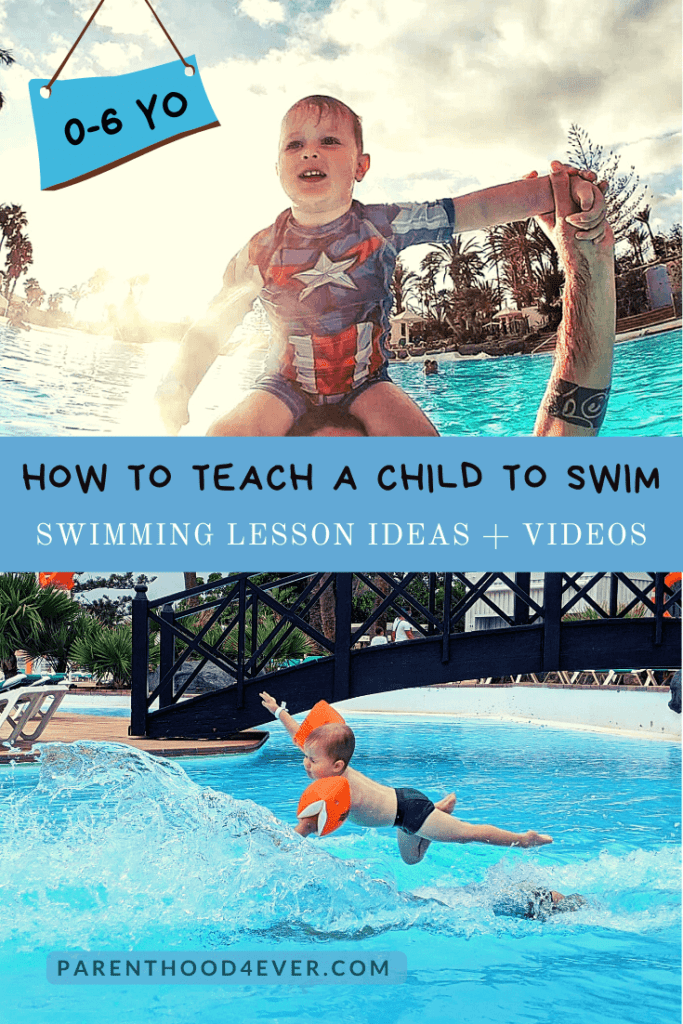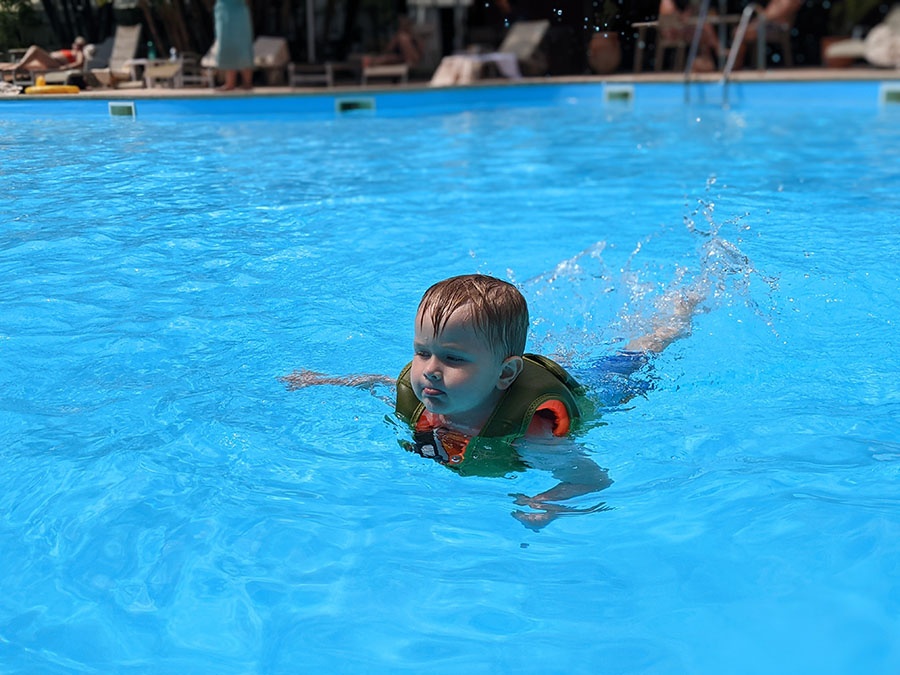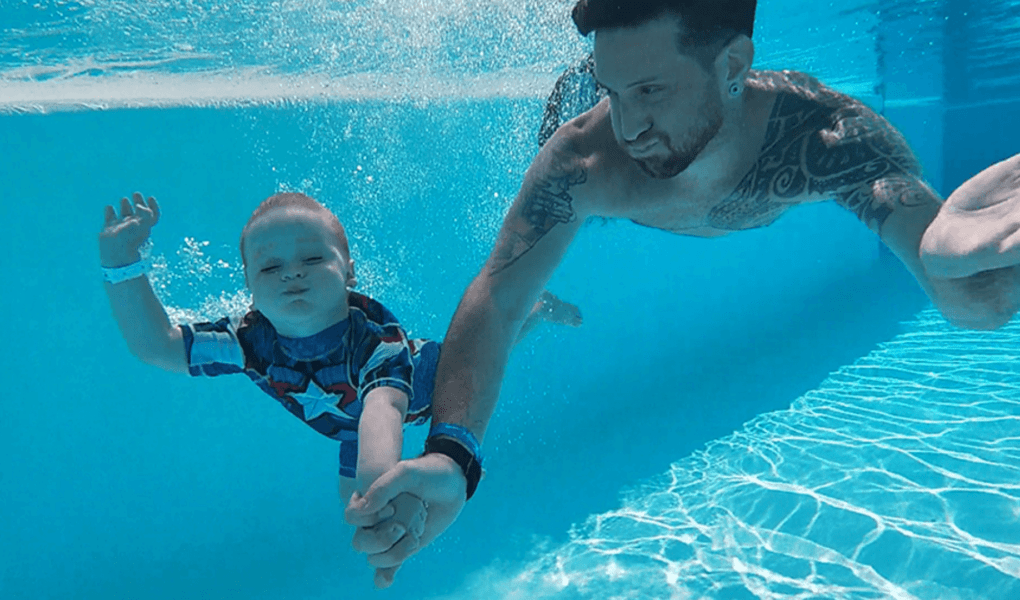“Studies show that the best time for a child to start learning swim basics is between the ages of one and four.”
How to teach a child to swim?
Teaching kids swimming is all about getting it natural in a playful form, with swimming lesson ideas in mind.
Whilst I have a superpower with presenting and teaching languages where all my games unconsciously have an educational base, my husband has a superpower of imagination, stories and great strength while playing. They get literally crazy when they play, so I always step out to avoid being hurt.
One of the many things my husband and I nailed with Teo is teaching him to swim and exist in water naturally. Today, I will share some tips and our experience about how to teach a child to swim with swimming lesson games in mind. Your child will be able to perform the following:
- Feel natural in the water.
- Behave and stay safe in the water.
- Swim underwater.

How to teach a toddler to swim: a starting point
Sink and bathtub
It all started at home, first in a sink, then in a bath and shower. It is important to get your child familiar with water from the first weeks of his life once the stump falls off. The stump will naturally dry up and fall off within a few weeks after birth.
Due to aquatic instinct, aka baby underwater reflex, in their first six months of life, it is very important to introduce babies to the water. Besides, it is not harmful but healthy to wet babies’ heads and eyes when taking showers with them, or perform quick little dives.
Taking warm showers with them is our favourite trick for the following reasons:
- It is easy.
- Babies love it because they feel you due to skin-to-skin contact.
- Babies feel so safe that they normally fall asleep while shower.
We recommend taking showers before bedtime, so your baby sleeps 4-6 hours straight.
One and only thing to remember is that to make babies natural swimmers, they should trust you.
This is all how it got started.
Baby swim classes
Teo and I used to take classes at the swimming pool in the UK and then Mexico. And occasionally we used to go to the swimming pool locally or when travelling abroad.
Swimming pools and beaches
It all started with trust.
What to teach a 2-year-old?
When Teo was two and a half years old, I sat him on the edge of the pool in Gran Canaria, slightly swam away, and invited him to swim towards me holding out my hands. (This is how to teach a 3-year-old to swim too if you have just started). Without a hesitation he did it. And once again. We repeated the process a couple of times, and then switched to other activities enjoying swimming together.
Remember to make it fun and effortless. Depending on the age, every activity shall take five to twenty minutes. However, let your child lead you, follow their desires. If he is up to training the whole day, then let it be.
Check what swimming lesson ideas, activities and swim games we have implemented at the age of two to three.
The next day we repeated the process. It is important to play along and be attentive to how your child feels, what he thinks is safe for him, what he likes doing the most. In the meantime, don’t forget to push them slightly and challenge them a bit.
Important: the success in teaching kids swimming is all about the engagement, encouragement, and play. Until your child is ready to attend swimming classes alone with a coach, meaning to listen to orders and train, try to always invent a game with them while swimming in a pool or sea.
How to teach a child to swim: key points to successful swim learning
- Build trust.
- Never show fear when something went wrong. Instead, joke about it or divert the attention.
- Try different types of floats, vests, body parts to make them feel comfortable. This is just for games and engagement.
- Talk about safety!!!
- Explain why it is important for your child to warn you of their actions. Let them tell you what they are going to do.
- Invent a few very simple swim signs, for example, show a closed fist out of the water when help is needed or lack of oxygen.
- Show a couple of swim tricks in an emergency event. For instance, how to tilt your head back to float and rest when tired.
- We don’t recommend too many swim accessories in the beginning, such as goggles or floats. Instead, let your child exist in the water naturally. Let them dive and reach you first.
- Try different forms and places to engage with water, t.i. shower, bathtub, beach, waterparks, fountains, cascades, rivers, or lakes, etc.
- Once the progress is made and you need to build up strength to swim, we strongly suggest using a swim vest. Vests help to position your child’s body correctly and aim for the following goals:
- Your child will learn how to use legs as they are now aligned with the body.
- Your child will build arm strength because they are the only now who support themselves and have to swim regardless, without your help.
After a few days working with the vest, take it off and let your child swim towards you freely. You will notice that they have built up enough strength in their arms to pull their body. Besides, they have received knowledge about how to lie their body down on the water, so that legs work properly and push them through towards you. This is one of the most practical ways to teach a child to swim.

- Repeat the process or new learning.
- Challenge your child once they achieve a goal.
- Always, always, always make it about the game!
- Make it fun!
- Go crazy!
This is why we created a series of videos for you to show a variety of swimming lesson ideas, swim games, activities, and techniques you can implement in the water.
It is important to learn to stay in the water naturally, dive in the water, and get used to being in the water. Unconsciously, we can pass our fear of swimming under the water with eyes closed, or that we need goggles or special vests/floats to avoid drowning. However, this may just create an unnecessary fear. What is important is to make a friendship with water, so in the beginning all exercises should be about feeling the water and getting used to it, e.g. breathing and seeing under it.
At the beginning stage it is not about teaching or doing it perfectly well, it is all about feeling the water, having fun there and enjoying the process. This is how your child will be hooked up with this sport.
At the age of three to four years, it is time when the child gets stronger and crazier. This is the time where they require more engagement, swim games, and activities. It is about performing crazy jumps and at the same time learning different types of techniques based around their safety.
Take a look at the videos to get a better idea on some of the techniques, activities and swimming lesson ideas we introduced (but not limited to).
- Build trust.
- Get rid of your fear if any, and never pass it on your child.
- Build responsibility and awareness.
- Give an understanding of general safety.
- Introduce side activities, such as snorkeling, water parks, surfing, etc.
- Teach basic signs underwater in case of emergency.
- Remember: it is all about small things that sum up.
- Repeat.
- Engage and encourage.
- Follow your child’s lead.
- It is very important to teach your child control to be able to save himself.
- It is also important to introduce breathing techniques.
Techniques:
- How to enter a pool and maintain the distance from a border.
- How to throw themselves or jump in the water.
- How to tilt their head back and rest.
- “Save your dad”.
- It is a lot about diving and staying underwater.
- It is also about controlling your child’s breath.
- Remember to turn every activity into a game and have some fun. For instance, shark games or focus games may help.
- Teach how to tackle the waves.
- Setting a cold mind when the danger comes.
- Working on using arms (getting rid of fists) and legs underwater.
- Grasping the strength by introducing the vest.
Finally, get crazy and playful. This is an important part where kids get engaged rather than feel that they are pressured to learn something. This is definitely a path to success to how to teach a child to swim. It is not an easy task, but swimming with your children is priceless.
Enjoy swimming with kids!
IMPORTANT: We created the Family Store, especially for you. By clicking on the image below you can find anything from Newborn’s First Kit, Baby & Family Essentials, Kids Travel to Travel Gear. We hope you will find something valuable for your own adventures!
Our shop contains products from other companies that we love and use! Everything is based on our values of quality over quantity.
To get more support from parents and family travelers, join our Parenting Support Group.
And follow us on Instagram to know about our crazy expat life!
Also, check out:
Welcome to check out our best product selection for parents and babies, including traveling gear and resources here.
This post may contain affiliate links that we may or may not receive a small commission, at no extra cost to you. This helps to fund our blog but we never advertise for anything we don’t personally love or recommend. There is never any pressure to buy anything, we just like sharing things that make our life easier and help you find them if it is something you are looking for. Please, see our full disclosure here.














[…] Check how we taught our kids to swim underwater naturally. […]